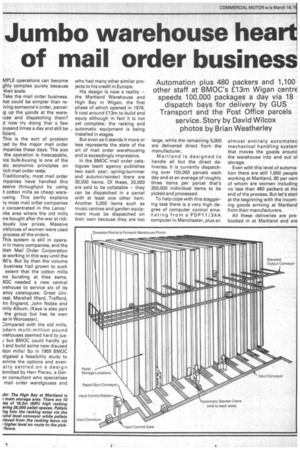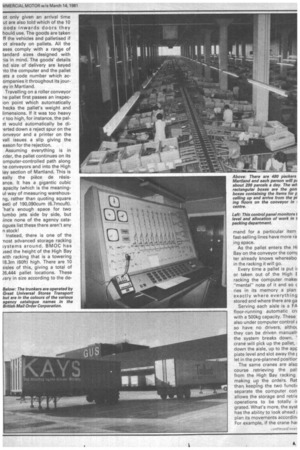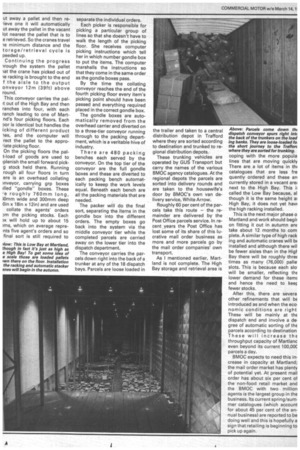Jumbo warehouse heart of mail order business
Page 40

Page 41

Page 42

If you've noticed an error in this article please click here to report it so we can fix it.
MPLE operations can become ghly complex purely because their scale.
Take the mail order business. hat could be simpler than reiving someone's order, parcel1g up the goods at the wareRise and dispatching them? lt now try doing that a few ousand times a day and still be ficient.
This is the sort of problem .",.ed by the major mail order mpanies these days. The size the operation is inescapable, )ce bulk-buying is one of the sic economic principles on lich mail order rests.
Traditionally, most mail order mpanies have handled this assive throughput by using I cotton mills as cheap wareusing. This partly explains -ty most mail order companies 3 concentrated in the Lancs/ irks area where the old mills ?re bought after the war at ridilously low prices. Massive )rkforces of women were used process all the orders.
This system is still in operaIn in many companies, and the itish Mail Order Corporation 35 working in this way until the 60's. But by then the volume business had grown to such extent that the cotton mills ?re bursting at thes earns. /IOC needed a new central ;rehouse to service six of its ency catalogues; Great Unirsal, Marshall Ward, Trafford, hn England, John Noble and mily Album. (Kays is also part the group but has its own se in Worcester).
Zompared with the old mills, Ddern multi-million pound ;rehouses seemed hard to jus/ but BMOC could hardly go t and build some new disused tton mills! So in 1969 BMOC ;tigated a feasibility study to amine the options and evenally settled on a design bmitted by Herr Pierau, a Germ consultant who specialises mail order warehouses and
who had many other similar projects to his credit in Europe.
His design is now a reality — the Martland Warehouse and High Bay in Wigan, the first phase of which opened in 1976, It cost around £13m to build and equip although in fact it is not yet complete; the racking and automatic equipment is being installed in stages.
But even as it stands it more or less represents the state of the art of mail order warehousing and is exceedingly impressive.
In the BMOC mail order catalogues (each agency publishes two each year; spring/summer and autumn/winter) there are 30,000 items. Of these, 20,000 are said to be collatable — they can be dispatched in a parcel with at least one other item. Another 5,000 items such as music centres and garden equipment must be dispatched on their own because they are too
ot only given an arrival time ut are also -told which of the 10 oods inwards doors they hould use. The goods are taken If the vehicles and palletised if ot already on pallets. All the ases comply with a range of tandard sizes designed with us in mind. The goods` details rid size of delivery are keyed -Ito the computer and the pallet ets a code number which acompanies it throughout its jourley in Martland.
Travelling on a roller conveyor he pallet first passes an inspecion point which automatically hecks the pallet's weight and.
limensions. If it was too heavy ,r too high, for instance, the pal
at would automatically be di • erted down a reject spur on the onveyor and a printer on the \fall issues a slip giving the eason for the rejection.
Assuming everything is in Icier, the pallet continues on its omputer-controlled path along le conveyors and into the High lay section of Martland. This is eally the piece de resisance. It has a gigantic cubic apacity {which is the meaningul way of measuring warehousng, rather than quoting square eet) of 190,090cum (6.7mcuft). That's enough space for two lumbo jets side by side, but ;ince none of the agency cataogues list these there aren't any n stock!
Instead, there is one of the nost advanced storage racking iystems around. BMOC has J sed the height of the High Bay ivith racking that is a towering 18.3m (60ft) high. There are 10 3isles of this, giving a total of a6,444 pallet locations. These vary in size according to the de mand for a particular item fast-selling lines have more ra ing space.
As the pallet enters the Hi Bay on the conveyor the comj ter already knows whereabo in the racking it will go.
Every time a pallet is put ii or taken out of the High E racking the computer make: "mental" note of it and so c ries in its memory a plan exactly where everything stored and where there are ga Serving each aisle is a FA floor-running automatic cri' with a 500kg capacity. These also under computer control z so have no drivers, althor. they can be driven rnanualh the system breaks down. crane will pick up the pallet, down the aisle, up to the apr piate level and slot away the let in the pre-planned positior The same cranes are also course retrieving the pall from the High Bay racking making up the orders. Rat than keeping the two functil separate the computer con allows the storage and retri€ operations to be totally ir grated. What's more, the syst has the ability to look ahead i plan its movements accordin! For example, if the crane ha;
ut away a pallet and then re-ieve one it will automatically ut away the pallet in the vacant lot nearest the pallet that is to
e retrieved. So the cranes travel le minimum distance and the torage/retrieval cycle is deeded up.
Continuing the progress irough the system the pallet lat the crane has picked out of le racking is brought to the end f the aisle to the output onveyor 12m (39ft) above round.
This conveyor carries the palrt out of the High Bay and then ranches into four, with each ranch leading to one of Martnd's four picking floors. Each or is identical but handles the icking of different product les, and the computer will rect the pallet to the appro. late picking floor.
On the picking floors the palt-load of goods are used to !plenish the small forward pick
g stock held there. Running rough all four floors in turn ere is an overhead collating mveyor, carrying grp boxes illed "gondle" boxes. These -e roughly 760mm long, iOmm wide and 300mm deep Oin x 18in x 12in) and are used
collate the agents' orders )m the picking stocks. Each )x will hold up to about 15 :ms, which on average reprents five agent's orders and so final sort is still required to separate the individual orders.
Each picker is responsible for picking a particular group of lines so that she doesn't have to walk the length of the picking floor. She receives computer picking instructions which tell her in which number gondle box to put the items. The computer marshalls the instructions so that they come in the same order as the gondle boxes pass.
By the time the collating conveyor reaches the end of the fourth picking floor every item's picking point should have been passed and everything required placed in the correct gondle box.
The gondle boxes are automatically removed from the overhead carrier and diverted on to a three-tier conveyor running through to the packing department, which is a veritable hive of industry.
There are 480 packing benches each served by the conveyor. On the top tier of the conveyor are the full gondle boxes and these are diverted to each packing bench automatically to keeep the work levels equal. Beneath each bench are all the packing materials that are needed.
The packer will do the final sort, separating the items in the gondle box into the different orders. The empty boxes go back into the system via the middle conveyor tier while the completed parcels are carried away on the lower tier into the dispatch department.
The conveyor carries the parcels down right into the back of a trunker at any of the 18 dispatch bays. Parcels are loose loaded in the trailer and taken to a central distribution depot in Trafford where they are sorted according to destination and trunked to regional distribution depots.
These trunking vehicles are operated by GUS Transport but carry the names of the various BMOC agency catalogues. At the regional depots the parcels are sorted into delivery rounds and are taken to the housewife's door by BMOC's own van delivery service, White Arrow.
Roughly 60 per cent of the parcels take this route — the remainder are delivered by the Post Office parcels service. In recent years the Post Office has lost some of its share of this lucrative mail order business as more and more parcels go by the mail order companies' own transport.
As I mentioned earlier, Martland is not complete. The High Bay storage and retrieval area is Above: Parcels come down th dispatch conveyor spurs right int( the back of the trunkers on the load ing banks. They are loose-loaded fo, the short journey to the Trafforc where they are sorted for trunking.
coping with the more popula lines that are moving quickly There are a lot of items in thi catalogues that are less fre quently ordered and these an currently stored in a vacant arei next to the High Bay. This called the Low Bay because, al though it is the same height a: High Bay, it does not yet hasp the high racking installed.
This is the next major phase o Martland and work should begir on fitting it out in autumn an take about 12 months to com plete. A similar type of high rack ing and automatic cranes will br installed and although there wil be fewer aisles than in the HiglBay there will be roughly three times as many (76,000) palle slots. This is because each slo will be smaller, reflecting the lower demand for these item: and hence the need to keep fewer stocks.
After this, there are severa other refinements that will be introduced as and when the eco. nomic conditions are right These will be mainly at the dispatch end and involve a de, gree of automatic sorting of thE parcels according to destination These will increase the throughput capacity of Martlanc even beyond its current 100,00C parcels a day.
BMOC expects to need this increase in capacity at Martland; the mail order market has plenty of potential yet. At present mail order has about six per cent oi the non-food retail market and the BMOC with two million agents is the largest group in the business. Its current spring/sum• mer catalogues (which account for about 45 per cent of the annual business) are reported to be doing well and this is hopefully a sign that retailing is beginning to pick up again.




























































































